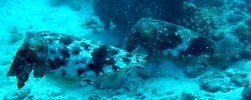Sepia
Katharina M. Mangold (1922-2003) and Richard E. YoungIntroduction
This genus is probably the most speciose in the Cephalopoda. Because of the great variability among species, the genus is best defined by the other two genera; that is, Sepia is the sepiid that doesn't have the major characters that define Metasepia and Sepiella.
Brief diagnosis:
- without pore at posterior end of mantle.
- with cuttlebone length approximately the same as mantle length.
Characteristics
- Head
- Beaks: Representative descriptions can be found here: Lower beak; upper beak.
- Beaks: Representative descriptions can be found here: Lower beak; upper beak.
- Funnel
- Funnel component of locking apparatus without pit-like depression at midpoint of groove.
- Mantle
- Mantle without posterior gland and pore (see Sepiella).
- Shell
- Cuttlebone length approximately equals mantle length.
- Cuttlebone usually with posterior spine between fins.
References
Adam, W. and W. J. Rees. 1966. A review of the cephalopod family Sepiidae. Sci. Rep. John Murray Exped. 11: 1-165.
Khromov, D. N., C. C. Lu, A. Guerra, Zh. Dong and S. v. Boletzky. 1998. A synopsis of Sepiidae outside Australian waters. Smithson. Contr. Zool., 586: 77-156.
Lu, C. C. A synopsis of Sepiidae in Australian waters. 1998. Smithson. Contr. Zool., 586:159-190.
About This Page
Katharina M. Mangold (1922-2003)

Laboratoire Arago, Banyuls-Sur-Mer, France

University of Hawaii, Honolulu, HI, USA
Page copyright © 2016 Katharina M. Mangold (1922-2003) and
 Page: Tree of Life
Sepia .
Authored by
Katharina M. Mangold (1922-2003) and Richard E. Young.
The TEXT of this page is licensed under the
Creative Commons Attribution-NonCommercial License - Version 3.0. Note that images and other media
featured on this page are each governed by their own license, and they may or may not be available
for reuse. Click on an image or a media link to access the media data window, which provides the
relevant licensing information. For the general terms and conditions of ToL material reuse and
redistribution, please see the Tree of Life Copyright
Policies.
Page: Tree of Life
Sepia .
Authored by
Katharina M. Mangold (1922-2003) and Richard E. Young.
The TEXT of this page is licensed under the
Creative Commons Attribution-NonCommercial License - Version 3.0. Note that images and other media
featured on this page are each governed by their own license, and they may or may not be available
for reuse. Click on an image or a media link to access the media data window, which provides the
relevant licensing information. For the general terms and conditions of ToL material reuse and
redistribution, please see the Tree of Life Copyright
Policies.
- Content changed 10 November 2012
Citing this page:
Mangold (1922-2003), Katharina M. and Richard E. Young. 2012. Sepia . Version 10 November 2012 (under construction). http://tolweb.org/Sepia/20009/2012.11.10 in The Tree of Life Web Project, http://tolweb.org/









 Go to quick links
Go to quick search
Go to navigation for this section of the ToL site
Go to detailed links for the ToL site
Go to quick links
Go to quick search
Go to navigation for this section of the ToL site
Go to detailed links for the ToL site